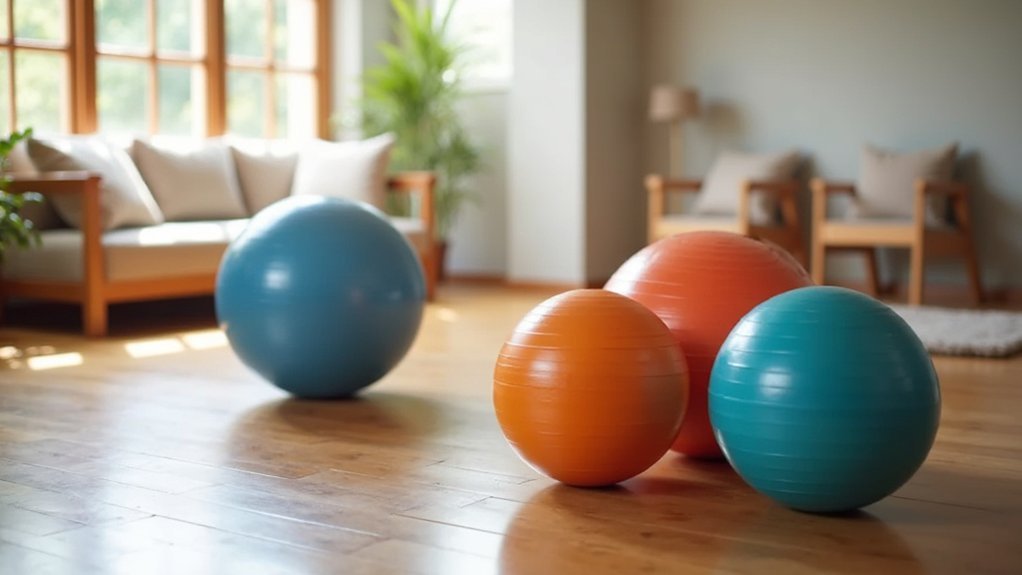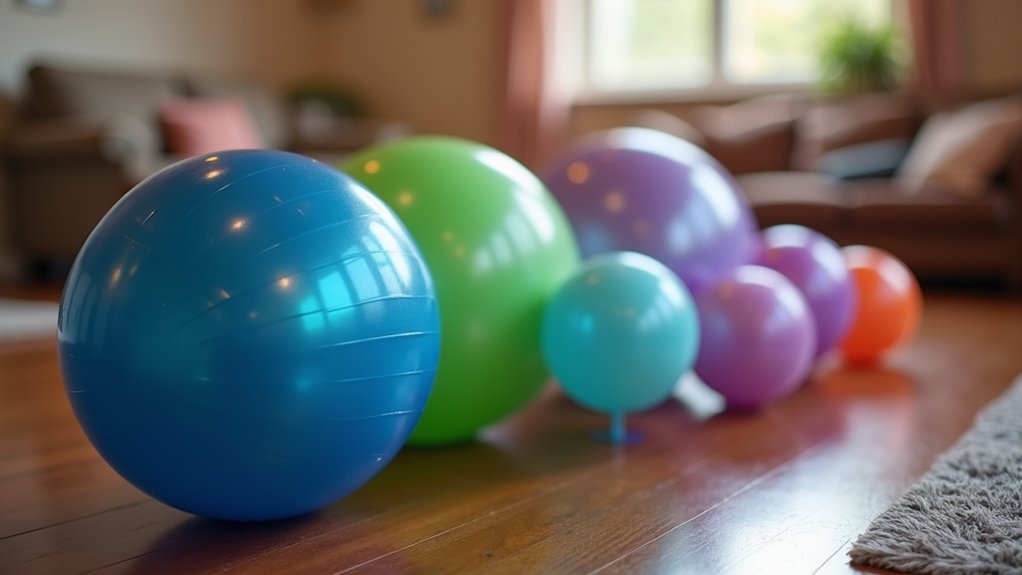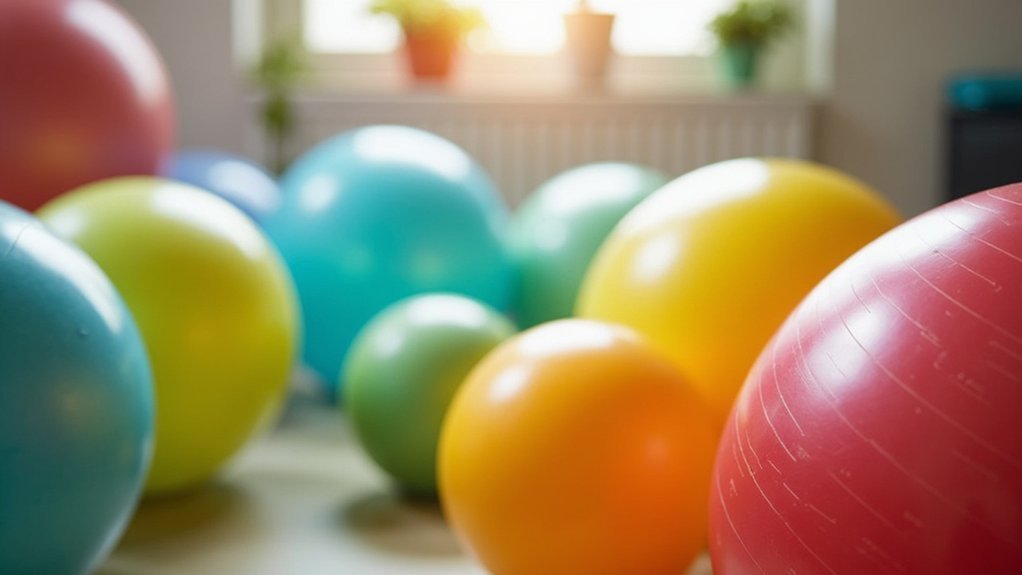The best stability balls for special needs adults include weighted balance models, sensory-friendly textured surfaces, anti-burst designs, ball-chair combinations, various sized therapeutic options, easy-maintenance versions, and those with support bases. You’ll want features that address specific needs while ensuring proper sizing for comfort and safety. Look for balls that prevent roll-away issues and provide sensory feedback. Our detailed guide explores each type’s unique benefits for physical therapy and sensory integration.
Weighted Balance Balls for Enhanced Stability

When standard exercise balls roll away unpredictably, weighted balance balls offer the perfect solution for special needs adults.
These specialized balls, priced at $31.95 (down from $39.95), prevent frustrating roll-aways while providing exceptional stability during therapy sessions.
Say goodbye to roll-away frustrations with our discounted weighted balance balls—exceptional stability for successful therapy sessions.
You’ll appreciate how weighted balance balls encourage proper posture and balance—critical benefits for individuals facing stability challenges.
Their thoughtful design makes them versatile tools for physical therapy programs, helping you or your loved one engage in exercises that enhance coordination and strength.
With regular use, these stability tools promote sensory integration while encouraging physical activity.
They’re particularly effective in rehabilitation settings where controlled movement is essential.
If you’re seeking cost-effective therapeutic equipment that won’t literally roll away from your investment, weighted balance balls deliver impressive results.
Sensory-Friendly Exercise Balls With Textured Surfaces
Textured exercise balls like the CanDo Inflatable Sensi-Ball ($15.95) offer unique tactile feedback that can help calm your nervous system during therapy sessions.
You’ll notice improved grip strength and control when using these sensory-enhanced surfaces, making movements more precise and intentional.
The varied textures provide essential sensory input that supports your motor planning and coordination while reducing anxiety during physical activity.
Tactile Engagement Benefits
Specialized sensory-friendly exercise balls with textured surfaces offer powerful tactile benefits for special needs adults.
When you incorporate these stability balls into exercise routines, you’re providing more than just physical support—you’re engaging the sensory system in meaningful ways.
The varied textures stimulate sensory receptors throughout the body, which helps develop essential motor skills and coordination. You’ll notice improved grip and control during activities, greatly reducing slip risks while enhancing safety.
For many adults with sensory processing challenges, these tactile elements create a calming effect that can reduce anxiety and improve focus during physical therapy sessions.
In therapeutic settings, these textured balls become valuable tools for sensory integration, creating opportunities for meaningful engagement while supporting physical development in a way that’s both effective and comforting.
Grip-Enhanced Movement Control
Grip-enhanced stability balls represent a significant advancement in movement therapy for special needs adults.
These textured surfaces provide improved control during exercises, allowing you to engage core muscles more effectively while maintaining proper posture and balance. CanDo Inflatable Exercise Sensi-Balls and similar products offer tactile engagement that makes physical activity both therapeutic and enjoyable.
- Textured surfaces prevent slipping, giving you confidence to try more challenging movements
- Enhanced grip features support development of motor skills and spatial awareness
- Grip-enhanced designs make independent exercise possible with reduced need for assistance
- Textured balls provide consistent tactile feedback, helping maintain proper form during core-strengthening exercises
You’ll find these specialized stability balls particularly beneficial for rehabilitation exercises, offering the sensory stimulation and stability needed for successful movement therapy sessions.
Anti-Burst Models for Safety and Longevity

Nearly all special needs adults benefit from stability balls that won’t fail suddenly during use. Anti-burst models are specifically designed with thicker PVC walls that resist immediate deflation even when punctured, providing vital safety during therapy sessions and exercises.
When selecting a stability ball, look for those explicitly labeled as anti-burst, which can withstand more pressure and everyday wear. Remember that proper inflation is important—too much air compromises the ball’s integrity, while too little reduces support effectiveness.
Textured surfaces on these specialized balls offer improved grip, minimizing slip risks during transfers or balance activities.
Make it a habit to regularly inspect your stability ball for signs of wear, particularly at pressure points, to guarantee continued safety and longevity for your special needs adult.
Ball-Chair Combinations for Postural Support
While traditional seating often lacks the support needed by special needs adults, ball-chair combinations offer an innovative solution that promotes proper posture and engagement.
When you’re choosing a stability ball chair, you’ll benefit from the dynamic seating that actively engages core muscles while providing comfortable support.
- Adjustable ball-chair setups accommodate your specific height and preferences, ensuring personalized posture support
- Core-engaging designs improve your balance and coordination during extended sitting periods
- Versatile options integrate easily into both therapeutic and home environments
- Active seating encourages movement that can boost your focus and concentration throughout the day
These combinations provide the perfect balance between stability and movement, helping you maintain proper spinal alignment while reducing discomfort associated with prolonged sitting.
Therapeutic Balls With Multiple Size Options

Selecting the proper size stability ball is fundamental to achieving therapeutic benefits for adults with special needs. Quality exercise balls typically come in several diameter options, allowing you to match the ball to the user’s height and specific therapeutic goals. When seated, the person’s knees should form a 90-degree angle for ideal support.
These versatile tools enhance gross motor skills and coordination while strengthening core muscles through various exercises.
You’ll find many therapeutic balls feature textured surfaces that provide sensory engagement—an important aspect for adults with special needs. The tactile experience engages multiple senses during stability work.
Textured stability balls deliver essential sensory input while building core strength—a dual benefit for special needs therapy.
When used consistently, these exercise balls can greatly improve balance, posture, and physical activity levels, contributing to greater independence and well-being for special needs adults.
Inflation and Maintenance Considerations for Caregivers
Maintaining your stability ball properly guarantees longevity and safety for special needs adults in your care.
You’ll need to master proper inflation techniques, establish regular cleaning routines, and implement smart storage solutions to prevent damage.
Remember that proper maintenance isn’t just about preserving your investment—it directly impacts the therapeutic benefits and safety of those who rely on these tools for physical support and sensory regulation.
Proper Inflation Techniques
Every stability ball requires proper inflation to guarantee safety and effectiveness for special needs adults.
When inflating your stability ball, you’ll need to achieve firm support that maintains shape without excessive squishiness—this guarantees proper posture during regular use. Use a high-quality pump rather than the included one, which may be inadequate for ideal inflation techniques.
- Inflate to approximately 80% capacity initially, then wait 24 hours before adding remaining air
- Measure the ball’s diameter to match the recommended size for your loved one’s height
- Check for proper firmness by sitting on the ball—knees should form a 90-degree angle
- Perform weekly inspections to identify signs of deflation or surface wear
Remember to keep stability balls away from sharp objects and heat sources to maximize their lifespan and safety.
Cleaning And Sanitizing
Regular cleaning and sanitizing of stability balls is essential for special needs adults who may have compromised immune systems or sensory sensitivities.
You’ll want to clean your stability balls frequently using a mild soap and water solution, avoiding harsh chemicals that degrade the material.
For proper sanitizing, mix 1 tablespoon of bleach per gallon of water, wipe down the ball thoroughly, then rinse well and dry completely. This helps eliminate germs without compromising the ball’s integrity.
Remember that special needs adults may react negatively to chemical residues, so thorough rinsing is vital.
While cleaning, inspect your stability balls for signs of wear or abrasions. Unfortunately, damaged balls can’t be repaired, so early detection prevents safety hazards.
After cleaning, store balls in cool, dry areas away from direct sunlight to maintain their longevity.
Storage Solutions
Proper storage goes hand-in-hand with the cleaning routine we’ve discussed. Keeping your stability balls in a cool, dry area away from direct sunlight prevents material degradation and extends their lifespan.
When working with special needs adults, maintaining organized, accessible exercise balls becomes essential for consistent therapy sessions.
Consider these practical storage solutions:
- Invest in ball racks or stackers if you’re managing multiple stability balls for group therapy sessions
- Perform quick visual inspections before each use to check for abrasions or signs of wear
- Keep a bike pump nearby for maintenance inflation—stability balls naturally lose air over time
- Designate a specific storage spot that’s both accessible to caregivers yet secure from accidental rolling or misuse
Balls With Support Bases for Independent Use
While traditional exercise balls can roll unpredictably, stability balls with support bases offer special needs adults the confidence to exercise independently.
The Weighted Balance Balls, priced at $31.95, feature support bases that prevent rolling away during therapeutic activities, providing essential stability for users with limited mobility.
Physical therapists often recommend these specialized balls to enhance balance and coordination during rehabilitation exercises. Their weighted design keeps them firmly grounded, considerably reducing fall risks while promoting safe, effective movement.
You’ll appreciate how these balls enable greater independence during therapy sessions, allowing you to focus on exercises rather than stability concerns.
With multiple variants available in the product line, you can easily find a ball that matches your specific needs and preferences for ideal therapeutic benefit.
Frequently Asked Questions
What Are the Therapy Balls for Autism?
Therapy balls for autism include Cando® Donut Exercise Therapy Balls and CanDo Inflatable Exercise Sensi-Balls. You’ll find they enhance core strength, provide sensory stimulation, and improve balance. Weighted options like Weighted Balance Balls offer additional stability.
What Is the Most Durable Stability Ball?
The TheraBand Pro Series SCP Exercise Ball is your most durable option with its thick PVC construction. You’ll also find the Power Systems VersaBall extremely reliable, supporting up to 600 pounds with its puncture-resistant material.
What Is the Difference Between a Medicine Ball and a Stability Ball?
Medicine balls are weighted (2-30 pounds) for strength training, while stability balls are inflatable, larger, and designed for balance exercises. You’ll use medicine balls for resistance and stability balls to challenge your core.
What Can I Use Instead of a Stability Ball?
You can use weighted balance balls, therapy balls, Cando® rubber medicine balls, sensory balls, or therapeutic chairs instead of a stability ball. They’ll provide similar benefits while offering enhanced stability and safety for your needs.
In Summary
Finding the right stability ball is an investment in comfort and independence for your loved one with special needs. You’ll want to take into account weight, texture, safety features, and versatility before making your choice. Remember, the perfect ball offers both therapeutic benefits and enjoyable sensory experiences. With proper maintenance and the right support accessories, you’re providing a valuable tool for improving balance, core strength, and daily functioning.





Leave a Reply